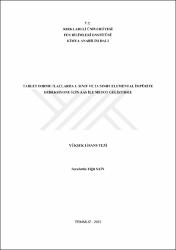| dc.contributor.advisor | Özcan, Cemile | |
| dc.contributor.author | Sain, Serafettin Yiğit | |
| dc.date.accessioned | 2021-12-11T19:41:38Z | |
| dc.date.available | 2021-12-11T19:41:38Z | |
| dc.date.issued | 2021 | |
| dc.identifier.uri | https://tez.yok.gov.tr/UlusalTezMerkezi/TezGoster?key=8tbPippmWV_b-Irrn9YEAvvzWwV4zdikx-aPYfUnxdkhBeuAMMht5dQrtuLOW5Yd | |
| dc.identifier.uri | https://hdl.handle.net/20.500.11857/1485 | |
| dc.description | YÖK Tez: 678808 | |
| dc.description.abstract | 22 Mart 2019 tarihinde yayımlanan uluslararası uyum konferansı kılavuzu ICH Q3D(R1) 'e göre, ilaçlarda indüktif eşleşmiş plazma (ICP) analizi uygulanarak elemental impüriteler için sınır konsantrasyonların belirlenebileceği yöntemler açıklandı. ICP cihazlarının bulunabilirliği zor ve sıfırdan temininin maliyetli olmasından dolayı, laboratuvarlarda daha sık bulunan ve yoğun olarak kullanılan atomik absorpsiyon spektroskopisi (AAS) ile aynı numune hazırlama teknikleri ile AAS cihazı kullanılarak metot adaptasyonu sağlandı. ICH kılavuzu en düşük tespit ve kantitatif dedeksiyon limitleri, grafit fırın atomik absorpsiyon spektroskopisi (GF AAS) cihazının tespit limitlerine uygundur. İlgili kılavuzda belirtilen en kritik ve limiti en düşük 1. Sınıf ve 2A sınıfı metallerin en sık kullanılan tablet formundaki ilaç numuneleri için metot geliştirme ve validasyonu çalışmaları gerçekleştirildi. 1. Sınıf arsenik (As), kadminyum (Cd), civa (Hg), kurşun (Pb), ve 2A sınıfı kobalt (Co), nikel (Ni), vanadyum (V). Örnek hazırlama mikrodalga destekli fırında, %65 HNO3 ve %37 HCl (5:1, h/h) karışımı asitle yakma kullanılarak gerçekleştirildi. | |
| dc.description.abstract | According to the international harmonization conference guide ICH Q3D (R1) published on March 22, 2019, the methods by which the limits for elemental impurities can be determined by applying inductively coupled plasma (ICP) analysis in drugs were anHayırunced. Due to the difficult availability of ICP devices and the cost of procurement from scratch, method adaptation was achieved using the same sample preparation techniques as atomic absorption spectroscopy (AAS), which is more common in laboratories and the AAS device. The ICH guide complies with the lowest detection and quantitative detection limits, detection limits of graphite furnace atomic absorption spectroscopy equipment (GF AAS). Method development and validation studies were carried out for the most critical and the worstcase limit Class 1 and Class 2A metals specified in the relevant guideline, and the drugs in tablet form samples which are used most frequently. Class 1 arsenic (As), cadmium (Cd), mercury (Hg), lead (Pb), and class 2A cobalt (Co), nickel (Ni), vanadium (V). Sample preparation was performed by microwave-assisted acid digestion using a mixture of 65% HNO3 and 37% HCl (5:1, v/v). | |
| dc.language.iso | tur | |
| dc.publisher | Kırklareli Üniversitesi | |
| dc.rights | info:eu-repo/semantics/openAccess | |
| dc.subject | Kimya | |
| dc.subject | Chemistry | |
| dc.title | Tablet formu ilaçlarda 1. sınıf ve 2a sınıfı elemental impürite dedeksiyonu için AAS ile metot geliştirme | |
| dc.title.alternative | Development and validation of an AAS method for quantitation of class 1 and class 2a elemental impurities in tablets | |
| dc.type | masterThesis | |
| dc.department | Enstitüler, Fen Bilimleri Enstitüsü, Kimya Ana Bilim Dalı | |
| dc.identifier.startpage | 1 | |
| dc.identifier.endpage | 40 | |
| dc.relation.publicationcategory | Tez | |
| dc.institutionauthor | Sain, Serafettin Yiğit | |



















